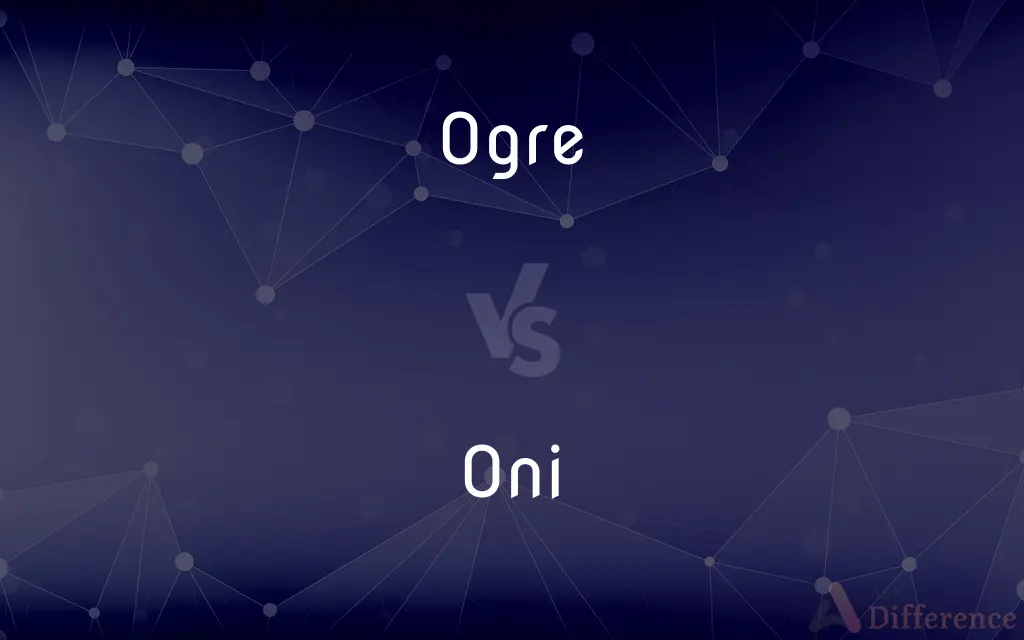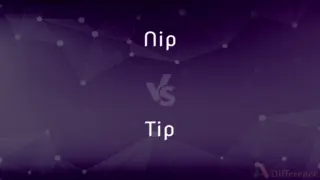Ogre vs. Oni — What's the Difference?
By Urooj Arif & Maham Liaqat — Updated on March 12, 2024
Ogres are mythical creatures often depicted as large, hideous, man-eating beings in Western folklore, while Oni are demonic ogres or trolls in Japanese folklore, known for causing disasters, spreading disease, and guarding hell.

Difference Between Ogre and Oni
Table of Contents
ADVERTISEMENT
Key Differences
Ogres, as featured in European folklore, are typically portrayed as large and fearsome giants with a voracious appetite for human flesh, often found in fairy tales and fantasy literature. They are known for their brute strength and are commonly depicted as being outwitted by humans. On the other hand, Oni in Japanese folklore are spirits or demons that come from the dead or are transformed from the wicked human souls. They are often depicted wielding clubs and causing harm, but they can also be protective spirits if appeased or converted.
The physical appearance of ogres is generally uniform, with descriptions highlighting their large size, ugliness, and often filthy attributes. They are depicted as solitary beings living in remote areas like forests or mountains. In contrast, Oni vary widely in their portrayal, often depicted with red or blue skin, multiple eyes or extra fingers, and horns. They are known to wear tiger-skin loincloths and carry iron clubs, called kanabō.
In storytelling, ogres are often antagonists, posing a threat to the protagonist through their physical might and appetite for humans. The tales usually involve ogres being outsmarted or defeated by clever characters. Oni, while also playing antagonistic roles, are more deeply woven into the spiritual and moral fabric of Japanese tales, serving as symbols of punishment for wicked deeds or as creatures that must be overcome, befriended, or transformed through virtue and perseverance.
Ogres reflect the fears and anxieties of medieval European societies, particularly concerning the unknown and the wilderness. Oni, however, are rooted in Shinto and Buddhist traditions, embodying the concept of karma and the belief in the transformation of spirits. They play a significant role during Setsubun, the Japanese festival for driving away evil spirits, where people throw beans outside their homes chanting, "Oni wa soto! Fuku wa uchi!" ("Demons out! Luck in!").
The narrative roles and symbolic meanings of ogres and Oni differ significantly across cultures. While European tales of ogres often emphasize physical strength and a lack of wits, Japanese stories about Oni incorporate themes of spiritual redemption, the consequences of evil actions, and the complex relationship between the physical world and the spiritual realm.
ADVERTISEMENT
Comparison Chart
Origin
European folklore
Japanese folklore
Nature
Mythical creatures, often giants
Demonic ogres or trolls
Characteristics
Large, ugly, man-eating
Red/blue skin, horns, causing disasters
Habitat
Forests, mountains, isolated places
Hell, earthly realms, causing calamities
Symbolism
Physical strength, fear of the unknown
Karma, punishment, protection against evil
Role in Stories
Antagonists, outwitted by humans
Antagonists or protectors, involved in moral tales
Cultural Significance
Medieval European anxieties
Shinto and Buddhist traditions, Setsubun festival
Appearance
Uniform, filthy attributes
Varied, often with horns, extra eyes or limbs
Attire/Weapons
N/A
Tiger-skin loincloth, iron club (kanabō)
Moral
Often outsmarted, embody physical danger
Symbolize the overcoming of evil, moral lessons
Compare with Definitions
Ogre
A large, fearsome giant in folklore, known for eating humans.
The children outsmarted the ogre hiding in the woods.
Oni
Depicted with red or blue skin, horns, and wielding clubs.
The fearsome Oni wielded a heavy iron club.
Ogre
Commonly featured in fairy tales and fantasy.
Fairy tales often include ogres as the villains heroes must defeat.
Oni
Represents karma and moral lessons in stories.
The story taught that even an Oni could find redemption.
Ogre
Solitary creatures living in isolated places.
The ogre lived alone in a mountain cave.
Oni
Demonic ogres in Japanese folklore causing calamities.
The Oni spread disease throughout the village.
Ogre
Symbolizes physical strength and the unknown.
The ogre in the tale represented the dark, uncharted forests of old.
Oni
Can be protective spirits when appeased.
Once respected, the Oni guarded the village from harm.
Ogre
Often depicted as dumb and ugly.
The ogre’s appearance frightened all who saw it.
Oni
Involved in rituals like Setsubun for driving away evil.
During Setsubun, they chant “Oni wa soto! Fuku wa uchi!” to expel Oni.
Ogre
An ogre (feminine: ogress) is a legendary monster usually depicted as a large, hideous, man-like being that eats ordinary human beings, especially infants and children. Ogres frequently feature in mythology, folklore, and fiction throughout the world.
Oni
An oni (鬼 (おに)) is a kind of yōkai, demon, ogre, or troll in Japanese folklore. They are typically portrayed as hulking figures with one or more horns growing out of their heads.
Ogre
(in folklore) a man-eating giant.
Oni
A Japanese evil spirit or demon.
Ogre
A giant or monster in legends and fairy tales that eats humans.
Oni
The military intelligence agency that provides for the intelligence and counterintelligence and investigative and security requirements of the United States Navy
Ogre
A person who is considered particularly cruel, brutish, or ugly.
Ogre
(mythology) A type of brutish giant from folk tales that eats human flesh.
Ogre
(figuratively) A brutish man reminiscent of the mythical ogre.
Ogre
An imaginary monster, or hideous giant of fairy tales, who lived on human beings; hence, any frightful giant; a cruel monster.
His schoolroom must have resembled an ogre's den.
Ogre
A cruel wicked and inhuman person
Ogre
(folklore) a giant who likes to eat human beings
Common Curiosities
Can Oni be considered good?
Yes, Oni can be protective spirits or symbols of redemption when respected or appeased, reflecting the complexity of their role in Japanese culture.
What are Oni?
Oni are demonic beings from Japanese folklore, known for causing disasters and guarding hell, but can also protect if appeased.
What are ogres?
Ogres are mythical creatures from European folklore, depicted as large, fearsome giants that eat humans.
How do ogres and Oni differ in appearance?
Ogres are typically depicted as large and ugly giants, while Oni have varied appearances, often with red or blue skin and horns.
What is the significance of Setsubun in relation to Oni?
Setsubun is a Japanese festival that involves rituals to drive away Oni and other evil spirits, symbolizing the expulsion of misfortune and the welcoming of luck.
What roles do ogres and Oni play in folklore?
Ogres are usually antagonists defeated by human cleverness, whereas Oni can be both malevolent forces and protective spirits, depending on the context.
Are there any similarities between ogres and Oni?
Both are often depicted as powerful, fearsome beings and serve as antagonists in folklore, but their symbolic meanings and cultural contexts differ significantly.
How are Oni depicted in Japanese art and culture?
Oni are depicted in various forms in Japanese art, often with distinctive features like horns, tiger-skin loincloths, and iron clubs, reflecting their complex roles in folklore.
What lessons do tales of ogres and Oni teach?
Tales of ogres often highlight cleverness and bravery in overcoming physical strength, while stories of Oni can teach about karma, redemption, and the importance of moral virtues.
How do ogres and Oni reflect cultural differences?
Ogres embody fears and anxieties of medieval Europe, such as the unknown and wilderness, while Oni are deeply rooted in Shinto and Buddhist traditions, embodying moral and spiritual themes.
Share Your Discovery

Previous Comparison
Trust vs. Trustworthy
Next Comparison
Nip vs. TipAuthor Spotlight
Written by
Urooj ArifUrooj is a skilled content writer at Ask Difference, known for her exceptional ability to simplify complex topics into engaging and informative content. With a passion for research and a flair for clear, concise writing, she consistently delivers articles that resonate with our diverse audience.
Co-written by
Maham Liaqat















































